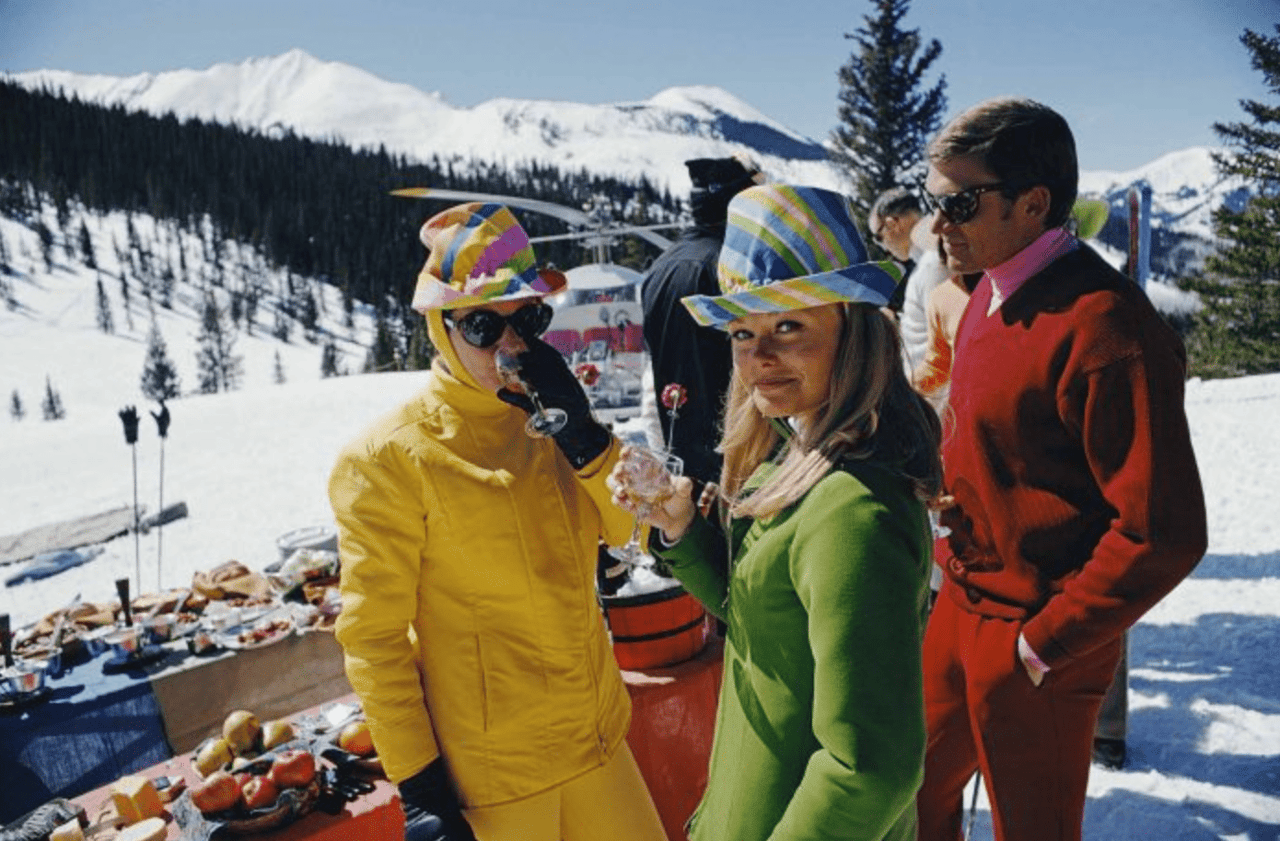How Après Ski Became a Cornerstone of Cocktails, Culture and Couture
Aprés

Aprés

Après ski, the hubbub of social activities that takes place after skiing, can be loosely defined as “partying,” says Seth Masia. The president of the International Skiing History Association has been participating in the winter sport for some 50 years, and, subsequently, après ski for about as long.
Meaning “after ski,” the term can describe a time of day, clothing style, type of cocktail, lifestyle signifier and more. In some circles, it’s used interchangeably with the shortened version, “après.”
The cherished tradition began in the 19th century, Masia says, when the British upper classes started spending winter holidays at Swiss ski resorts. Their drink of choice was predominantly hot tea, intended to warm up cold bodies. An alcohol-fueled après ski tradition emerged in the 1950s, explains Masia, and inspired dance parties referred to as “tea dancing,” due to the afternoon hour and tea-soaked origins. Dancing also helped heat things up, and the accompanying beverages evolved to incorporate drinks native to the Alps like schnapps, brandy, beer and various forms of mulled wine.
While après ski is still very much a part of the skiing experience in the U.S., the dancing tradition “has kind of gone by the wayside,” says Masia. “Bars and restaurants pay very, very high rents, real estate is so valuable, and they want to maximize the number of dining tables” and the number of times they can turn them over to new guests.
Whether the music is muted or party-starting, there’s one modern-day après-ski mainstay, and it’s called alcohol. Hot beverages like hot toddies, spiked hot cocoa and mulled wine continue to be traditional favorites, says industry veteran Tad Carducci. “Anything hot will be a fixture in any town or resort that features après,” he says. Currently a Gruppo Montenegro representative, Carducci’s introduction to après culture was aided by time spent slinging drinks at New Jersey’s Mountain Creek, a ski resort. He’s also spent some 40 years skiing and après-ing himself.
For him, après ski has always been about “being a little bit raucous, a little bit fun.” Even if the festivities are tame, après ski provides “time to unwind and relax with friends” following a leg-burning workout, he says.
What après partakers drink and eat is dictated by their chosen bar or restaurant’s menu and vibe, according to Berkshire-based Holly Berrigan. She and her husband, Nic Jansson, are both avid skiers in their early 30s and have conquered slopes in Switzerland and throughout North America. In their experiences, après varies based on location. “We eat nachos or poutine if we head up to Canada and have beers at the bar,” says Berrigan.
Masia calls himself a beer guy and says that beer has long been a popular choice for après skiers. Plus, the craft brewery movement in states like Colorado, Oregon and Vermont, many of which just so happen to have ample ski acreage, has kept beer at the après forefront in the U.S.
“Loaded nachos, beer and après are as synonymous as peanut butter and jelly—especially if you live in the Tetons,” says Roadhouse Brewmaster Max Shafer. His latest creation, Loose Boots Après IPA, was brewed in partnership with Jackson, Wyoming-based Stio Outdoor Apparel. And on November 25, 2021, Big Sky Resort in Montana in partnership with MAP Brewing released a limited-edition beer, Swifty Session Pale Ale, to celebrate its new chairlift, Swift Current 6—along with the start of the 2021-22 season.
Berrigan thinks “younger generations are embracing far less posh versions of the après-ski, though many of the key elements are still there, like lots of melty cheese.” And so, you’re unlikely to find Champagne outside of the Zermatts and Chamonixes of the ski world.
A less posh après has also resulted in changing fashion choices. In the early days of après, people got dressed up for the occasion, ditching their clunky ski boots and thick layers of clothing for more stylish attire like “stretch pants” favored for the way they “displayed their butts,” Masia says of 1950s and ’60s après clothing. While you can certainly catch glimpses of high-fashion getups in places like Aspen and Vail, which tend to attract an affluent clientele, today it’s more common to go to cocktail hour straight from the mountain, with a shower and change of clothes occurring after après but before dinner.
Another way that après is evolving? Low-alcohol drinks are increasingly popular, says Carducci. It’s a departure from the scene he remembers in Killington, Vermont in the late ’90s and early aughts, when crazy alcoholic rum concoctions dominated. “You know,” says Carducci, “it was like a college frat party.”
By: Stacey Lastoe I Wine Enthusiast I February 2022